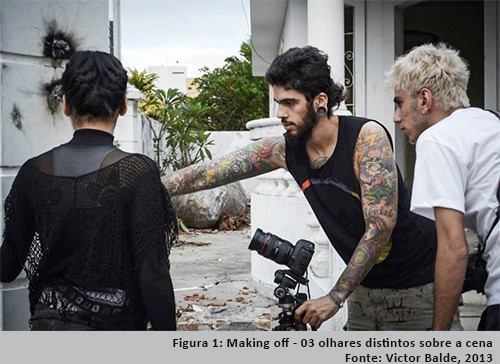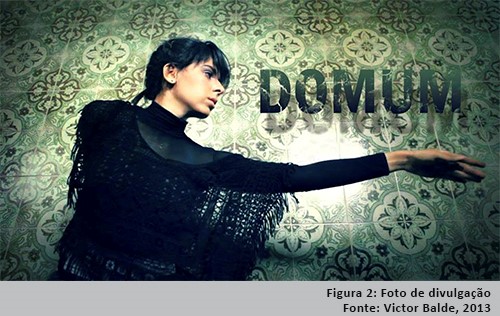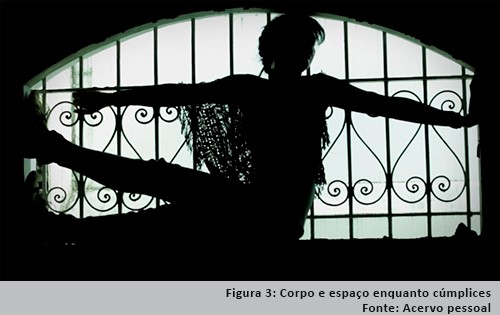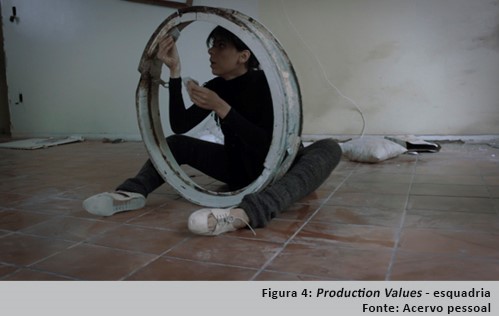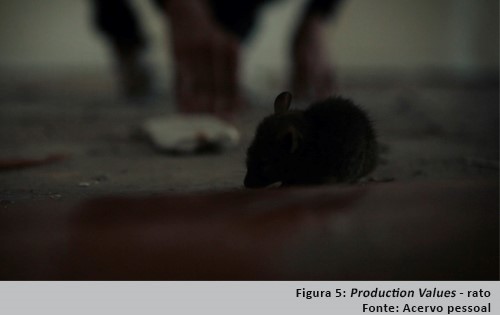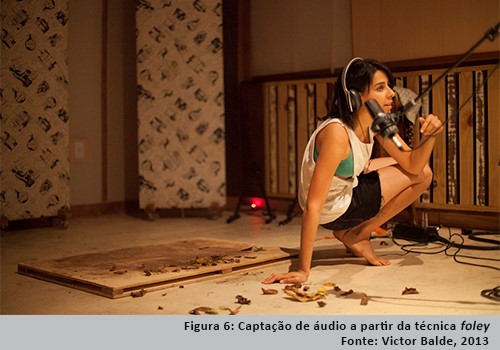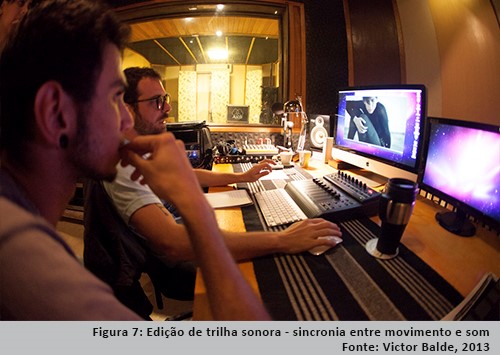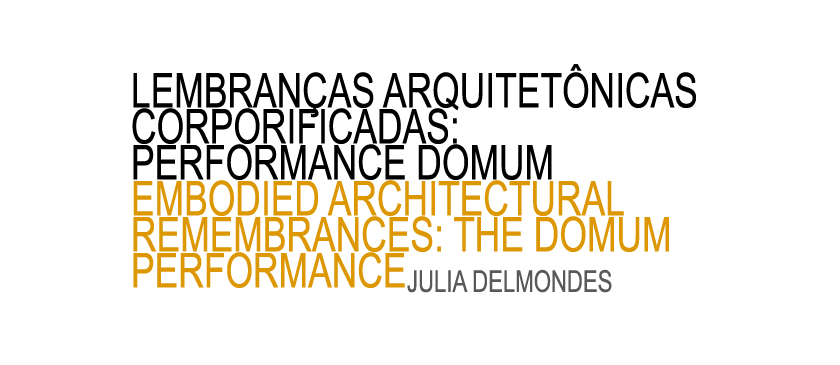
Lembranças arquitetônicas corporificadas: performance “Domum”
Julia Delmondes Santana é arquiteta e urbanista. Estuda arquitetura e cenografia, e vivências urbanas por intermédio da linguagem poética.
Como citar esse texto: DELMONDES, J. Lembranças arquitetônicas corporificadas: performance "Domum". V!RUS, São Carlos, n. 15, 2017. [online] Disponível em: <http://www.nomads.usp.br/virus/virus15/?sec=7&item=1&lang=pt>. Acesso em: 14 Jul. 2025.
Resumo
Esta pesquisa busca compreender em que medida o desenvolvimento da experiência corporal, mediante práticas artísticas, se faz fundamental no entendimento do ser perante suas possibilidades de ação [vivência] no mundo. Diariamente, o corpo encontra-se em diálogo com o ambiente e compartilha sensações durante toda sua existência, sendo impossível separá-los. Entende-se que a arte pode ser vista como uma expressão disposta a reforçar as relações entre o sujeito e o universo sensível através de experiências subjetivas que permitem registrar a memória vivenciada, instaurar lembranças e ressignificar conceitos objetivos e paradigmáticos. Assim, o objetivo específico deste artigo é analisar o experimento artístico intitulado “Domum”, que ao unir performance, fotografia, vídeo, música e arquitetura, propôs evidenciar a potência de um espaço abandonado na cidade de Aracaju/SE e suas possibilidades de vivência e percepção.
Palavras-chave: Lembranças corporificadas, Corpo, Espaços abandonados, Arquitetura, Experiência artística
1 Introdução
Compartilhar uma lembrança é sempre um momento presente de reproduzir histórias ou recriar memórias através de uma linguagem; é relembrar circunstâncias e instaurar novas percepções a partir das experiências que residem no agora. Ao tentar trazer à tona a lembrança de uma experiência arquitetônica, questiono como posso transmitir em linguagem textual e linear o que experimentamos com o corpo e com a imaginação, uma vez que as palavras não são suficientes? Dessa maneira, acredito que a linguagem artística permite uma comunicação que aproxima o experimento corporal do indivíduo que busca o registro da memória vivenciada.
Através de um trabalho artístico transdisciplinar entre performance, fotografia, vídeo, música e arquitetura, foi desenvolvido um vídeo-dança enquanto suporte visual de uma vivência em um espaço abandonado na cidade de Aracaju (SE). Este encontro entre corpo e espaço será analisado a partir de lembranças que ativam a construção de uma memória vivida pelo corpo. Nesta perspectiva da experiência, surge a intenção da poética enquanto uma expressão do próprio ser que reúne passado e presente em um espaço fenomenológico advindo de ressonâncias íntimas e individuais.
Sem precedentes teóricos, a vivência surgiu de maneira espontânea e, posteriormente, apoiou-se em alguns autores da arquitetura e da arte contemporânea com a pretensão de aproximar algumas reflexões importantes acerca da percepção de um corpo ativo que, frequentemente, instaura sensações ao percorrer espaços e cultivar lembranças corporificadas.
Portanto, para melhor compreensão, este artigo foi dividido em 04 momentos que buscam trazer uma “ordem” da experiência vivenciada. A princípio, iniciaremos com o encontro poético entre corpo e espaço abandonado compreendendo suas potencialidades a partir do vazio e da materialidade gasta. Posteriormente, será descrita a execução da performance e seus elementos de suporte que auxiliaram a concretização do produto artístico final.
Por fim, a intenção deste artigo é demonstrar que a arte pode ser vista enquanto uma linguagem disposta a reforçar as relações entre o sujeito e o universo sensível mediante experiências subjetivas que permitem [des]construir memórias e ressignificar conceitos objetivos e paradigmáticos.
2 Encontro poético entre corpo e espaço
Iniciaremos este artigo refletindo sobre a relação corpo e espaço compreendendo-os enquanto elementos uníssonos que, juntos, reverberam e ativam dinâmicas propensas à experiência. Aqui, pensaremos a arquitetura enquanto espaço articulado que abriga o indivíduo e media relações, nos impulsionando a compreender o corpo enquanto um elemento ativo na apreensão do espaço e suas possibilidades. Neste sentido, é valido ressaltar que as experiências arquitetônicas estão além da percepção visual e do caráter objetivo de seus elementos, proporcionando descobertas e vivências que ultrapassam a materialidade e redirecionam “nossa consciência para o mundo e nossa própria sensação de termos uma identidade e estarmos vivos” (PALLASMAA, 2011, p. 11). Assim, podemos compreender que o diálogo entre corpo e espaço possui uma grande significação, não somente a quem o possui enquanto abrigo e proteção, mas também a quem se permite vivenciá-lo e experimentá-lo além do olhar ao explorar os demais sentidos.
Esse pensamento acerca do corpo ativo na configuração espacial é relevante uma vez que, segundo Bernard Tschumi (2008), o corpo é o ponto de partida e o ponto de chegada da arquitetura ao produzir espaços por meio e através dos seus movimentos, tornando-se a ação dos eventos nos espaços arquitetônicos. Assim, segundo o autor:
O cheiro penetrante de borracha, de concreto, de carne; o gosto da poeira; o roçar desconfortável do cotovelo sobre uma superfície abrasiva; a sensação prazerosa de paredes felpudas e a dor de esbarrar em uma quina no meio da escuridão; o eco de um salão – o espaço não é simplesmente a projeção tridimensional de uma representação mental, mas é algo que se ouve e no qual se age. E é o olho que enquadra - a janela, a porta, o ritual efêmero da passagem [...]. (TSCHUMI, 2008, p.181).
Neste contexto, o encontro poético entre corpo e espaço proposto neste trabalho, busca transgredir a funcionalidade programada do espaço arquitetônico visando reconhecer possibilidades de ação que alcancem novas aberturas de fruição e vivência no espaço. Para elucidar tal vivência, é proposta aqui uma performance artística como suporte para atenção à ação que busca ir além das interpretações reducionistas da arquitetura. Segundo Sandra Cinto (apud CANTON, 2009, p.49) “percepção requer envolvimento” e um dos grandes desafios do artista contemporâneo é criar estratégias para que um corpo em trânsito pare e preste atenção ao que está sendo abordado. Dessa maneira, a performance apresentada tem como objetivo ampliar a percepção espaço-temporal mediante uma experiência em um espaço abandonado, um “lugar de memória”. De acordo com Zonno (2014):
A inserção de objetos contemporâneos em “lugares de memória” tem como resultado, sempre, um fenômeno que reúne passado-presente, a ser experienciado no tempo e no espaço reais, ativando a percepção simultânea de múltiplas temporalidades, também ampliando as possibilidades de significação da paisagem. Lugares de memória, as ruínas constituíram, ao longo da história, campo para fruição do pitoresco ao sublime. Na atualidade, estratégias de intervenção in situ em ruínas potencializam ambas as dimensões estéticas ao passo que mobilizam também a memória (ZONNO, 2014, p.495).
Assim, o encontro com o espaço abandonado nesta performance artística será analisado a partir de uma experiência própria e direta do ser que vivencia e desperta lembranças que ativam a construção de uma memória vivida pelo corpo. Nesta perspectiva da experiência, surge a intenção da poética enquanto uma expressão do próprio ser que reúne passado e presente em um espaço fenomenológico advindo de ressonâncias íntimas e individuais. Segundo Bachelard (2008), a poética se mostra imprevisível, alcançando qualquer olhar que esteja atento ao desconhecido e aberto ao devir. Isso nos conduz, portanto, a um segundo momento deste artigo: a compreensão do espaço edificado abandonado enquanto uma articulação do vazio que proporciona a abertura de novos caminhos e interpretações.
3 Vazio enquanto potênciaO artista Yves Klein, em sua obra “Le vide”, de 1958, buscou evidenciar o vazio além do sentido de negação, de falta, e sim enquanto um estado de abertura, liberdade e otimismo ao revelá-lo em sua totalidade e em seus novos territórios ainda inexplorados (TEIXEIRA, 1999). Depreende-se, portanto, que o vazio é “cheio” de descobertas, caminhos, porvires e que, partindo do ponto de vista apresentado, permite transcender lógicas estabelecidas provocando o surgimento de significados mediante o despertar de circunstâncias e eventos não planejados. Para Rocha (2010, p.313), “no vazio, somos livres, entramos em uma dimensão arquitetônica onde tudo é possível, não existe nem passado, nem futuro, apenas o presente”.
Sobre os espaços abandonados no contexto urbano, Solà-Morales (2002) em seu texto Terrain Vague os define enquanto lugares esquecidos, obsoletos e periféricos que, em sua maioria, estão atrelados à construção de sentidos negativos perante as experiências urbanas. Entretanto, quando ressaltados em suas potencialidades - aqui evidenciados mediante experimentos artísticos - nos conduzem a outra lógica urbana e nos apresenta a uma dimensão desconhecida e aberta ao possível. Tal como um “entre-lugar”, definido por Guatelli (2012, p.63) como “ausências capazes de produzir presenças, [que] não apontam caminhos, não direcionam ou definem usos, mas, ao contrário, possibilitam a abertura de caminhos, usos e ações imprevistas”, os espaços abandonados são capazes de adquirir múltiplos significados. A partir dessa abordagem pode-se depreender que o olhar atento do indivíduo à interação com esses espaços, tenderá a um novo sentido. Assim, tal interpretação e subjetividade dependem de um ser que se identifique, perceba-o e o preencha de significados.
Neste ponto do trabalho é válido ressaltar que as performances artísticas surgem como criação de algo que leva o indivíduo – artista ou espectador – a aproximar-se do real, da natureza do acontecimento, estabelecendo transgressões espaciais em suas ações. Desde a década de 70, diferentes artistas ressaltam lugares de memória marginalizados, como resistência às estratégias de poder e à rapidez da vida cotidiana atual, por meio de performances, intervenções de teatro, música, dança entre outros. Jeanne-Marie Gagnebin (2007), referindo-se ao último volume da obra de Marcelo Proust “Em busca do tempo perdido”, propõe a seguinte reflexão acerca da evocação da memória destes espaços:
Então se reencontra algo que tinha sido perdido sem mesmo perceber: não é um tempo esotérico, solene ou majestoso, mas a intensidade efêmera de um momento esquecido do passado que, pela súbita junção com a temporalidade da sensação presente, adquire uma profundidade repentina, como se ele ecoasse um apelo que vem de longe, de um instante soterrado no passado e que, de repente, passa a ter um futuro possível. Ou ainda: o presente não é somente ponto de inflexão indiferente entre o antes e o depois; e o passado não é simplesmente algo encerrado e morto. Em seu encontro recíproco, ambos passado e presente, assumem uma intensidade sensível que lhes outorga novamente aquilo que parecia perdido: a abertura sobre uma dimensão desconhecida, a abertura sobre o possível [...] (GAGNEBIN, 2007, p.109).
Desse modo, o entusiasmo da arte contemporânea por espaços vazios e esquecidos será retratado na próxima etapa deste artigo mediante a descrição da performance intitulada “Domum”. Formatado em um vídeo-dança, o trabalho foi produzido pela autora com o intuito de instaurar um debate que contribua para ressaltar a relação corpo x espaço e suas possibilidades de construção de significados em espaços abandonados.
4 “Domum”
Entende-se que a linguagem disposta a criar relações com o universo sensível, advindas da imaginação pode ser encontrada nas expressões artísticas, mediante experiências subjetivas que transpassam superfícies concretas e materiais. Segundo Woodfield (2012, p.567), “a linguagem é mais do que um instrumento de comunicação, mais do que um conjunto de rótulos para ser afixado a pessoas e objetos que existem em nosso ambiente. Ela precisa ser criativa para desempenhar funções vitais”. Assim, formatado em um curta-metragem, o vídeo-dança “Domum” busca comunicar, através da linguagem do audiovisual e da performance, as potencialidades do vazio e do espaço abandonado ressaltadas pela experiência.
Partindo do pressuposto que a construção de significados do espaço advém do uso, acredita-se que o empirismo em consonância com a arte proporciona o despertar de sentidos relevantes na manutenção da vida em sua potência. Desse modo, a arte contemporânea ao valorizar as ruínas de maneira poética, reconhece o homem enquanto um ser impotente na ordenação e controle do mundo, aproximando-o do real e da sua degradação inevitável (ZONNO, 2014).
A performance “Domum” permitiu que os indivíduos envolvidos experimentassem possibilidades de ação em um cenário urbano, que a cada dia se torna mais limitador em seu cotidiano. Diariamente, a cidade de Aracaju (SE) vem crescendo sem a construção de um pensamento crítico sobre sua arquitetura, inserindo-se em uma estrutura pragmática e sem motivações reflexivas acerca do seu desenvolvimento urbano. Dentro desse contexto, o “Domum” surgiu com o intuito de realçar, poeticamente falando, a experiência nos espaços menos óbvios da cidade enquanto brechas que dialogam com os indivíduos através da sua materialidade gasta e auxiliam no pensar a cidade contemporânea além dos objetivos consensuais e limitados em si.
A intervenção aqui tratada foi uma ação performática em uma residência em processo de demolição localizada na Av. Beira Mar, no bairro 13 de Julho, em Aracaju/SE. A ideia inicial dessa ação surgiu ao presenciar a destruição de uma residência de caráter arquitetônico neocolonial, inserida em uma área nobre de grande especulação imobiliária. A diferença entre as edificações recém-construídas e a casa foi ressaltada durante o processo de demolição instaurando questionamentos sobre a transformação daquela paisagem. Durante este curto instante de mudança na paisagem, a casa surgiu, aos olhos da artista, como um objeto com potencial poético para ser reinventado e registrado a partir de uma experiência artística que valorizasse sua memória e possibilidades. De acordo com Rocha (2010), o abandono ali presente desapegou materialidades, visualmente óbvias, e imaterialidades no campo dos sentidos, que desencarnou dos corpos arquitetônicos e habitou fronteiras, escapes e fuligens.
O ponto de partida para o roteiro inicial surgiu diante de uma mulher errante (performer) que passava pela avenida e deparava-se com uma paisagem antagônica [construção e demolição]. Em seguida, ela se questionou sobre os mistérios e imagens que aquela casa podia abrigar e, sem nenhum conhecimento sobre os precedentes do imóvel, permitiu-se adentrar o universo do descaso e experienciar a poética do vazio em movimentos cadenciados, dançados e sentidos.
A performance proposta também foi vivenciada pelo olhar do fotógrafo e do diretor de arte, uma vez que os momentos foram compartilhados e sincronizados entre os três artistas. A partir das câmeras subjetivas acompanhando os passos da performer, percebeu-se que os corpos dos outros participantes também estavam inseridos na mesma dimensão espacial, entretanto cada corpo configurava suas próprias grafias mediante sua movimentação individual (fig. 1 e fig. 2).
A casa, objeto arquitetônico, pôde ser compreendida neste trabalho como a principal fonte para a concepção de imagens poéticas, uma vez que sua materialidade gasta mostrava-se cada vez mais sensível e frágil durante as etapas de desapego. A todo instante, os elementos que residiam naquele espaço seduziam os artistas em questões sobre suas memórias de passado e sobre seu destino. A sensação de se identificar com a ruína devido à constatação de um destino inevitável, da morte, permite que o sujeito a vivencie em espaço e tempo real enquanto experiência presente. Esta poética da ruína pode ser mais bem compreendida a partir da seguinte reflexão:
Levantamos como hipótese que uma interpretação poética da relação entre a intervenção e a ruína possa ampliar suas possibilidades de valorização, para além dos valores de rememoração, como arte. Experenciamos o fenômeno ruína-intervenção, passado-presente, através do corpo, no espaço e no tempo, fruindo a pátina do tempo e sua re-descoberta, ativando a sensibilidade e a memória (ZONNO, 2014, p. 498).
Tocar o pilar e deixar o rastro da mão sobre a sujeira significava compreender que a presença do corpo, naquele momento, acrescentava marcas e compartilhava de seus últimos suspiros. A vegetação presente, suja com detritos da demolição já exibia pouco vigor. O vento que atravessava os vãos das esquadrias sustentava o vazio, e a todo instante renovava o espaço, ressoando devaneios distantes. Os elementos como caixa de correio, placa de rua e número da casa carregavam características sinuosas realçando a identidade da residência e emitindo marcas de um tempo vivido. Todas as percepções destes elementos foram ressaltadas quando os sentidos corpóreos eram acionados a partir de uma percepção direta ou periférica.
Nesse contexto, após o início da performance no interior da casa, vislumbrou-se um estreitamento da relação da performer com o espaço, revelando devaneios e sonhos acrescidos de sentimentos que, rapidamente, os tornaram cúmplices. Bachelard (2008, p.26) auxilia essa compreensão quando diz que “evocando as lembranças da casa, adicionamos valores de sonho. Nunca somos verdadeiros historiadores, somos sempre um pouco poetas, e nossa emoção talvez não expresse mais que a poesia perdida”.
Dessa maneira, os movimentos do corpo surgiram de maneira cadenciada, expondo impulsos que algumas vezes encaixavam-se no espaço (Fig.3). A dança, sem coreografia programada, criou, durante o processo, uma nova grafia, buscando propor diferentes maneiras de ocupar e perceber o espaço.
Um importante aspecto que vale ressaltar neste trabalho foi o aparecimento dos chamados production values durante o momento da performance. Traduzido como “valores de produção”, esse fenômeno é considerado importante quando elementos surgem de surpresa, sem programação no espaço da ação, e agrega valores ao produto artístico final. No “Domum” foram encontrados 02 (dois) elementos importantes: uma sobra de esquadria que foi agregada à composição do movimento, e um rato debilitado que, ainda em vida, representava a fragilidade daquele lugar (Fig. 4 e Fig.5).
No fim da experiência, os artistas deixaram a casa, reconhecendo que a atmosfera do vazio abrigou 03 (três) indivíduos que, despretensiosamente, se dispuseram a ampliar sua percepção espacial a partir de uma experiência corpórea. Para Maurice Merleau-Ponty (2003, p.21) “as coisas passam por dentro de nós, assim como nós por dentro das coisas”.
5 Domum editado: [revi]vendo experiências
Após o fim da performance, pensou-se na possibilidade de captar imagens no último dia da demolição, com o objetivo de mostrar todas as etapas do processo de abandono do objeto arquitetônico; estas imagens permitiram que o vídeo aproximasse ainda mais o espectador da realidade da performance e do seu contexto.
Um fator importante no momento da pós-produção foi o acréscimo da trilha sonora enquanto elemento capaz de proporcionar intensidades diferentes aos movimentos, tanto da dança como do audiovisual. No momento da execução, a performer obteve estímulos sonoros aleatórios, sem apego a melodias ou a sons definidos. Ou seja, caberia agora encontrar uma trilha que melhor se adequasse ao vídeo finalizado.
Por fim, depois de editado, surgiu o nome “Domum”, que no latim significa “casa”. Objetivo, curto e de fácil pronúncia, o nome contribuiu para maior identificação entre o espectador e a obra, uma vez que esta palavra é carregada de lembranças e significados pessoais. Pode-se dizer, então, que o produto final e os resultados desta experiência foram relevantes àqueles que se dispuseram experimentar o acaso através da performance proposta. O exercício de aguçar a percepção, através dos demais sentidos corpóreos, contribuiu para uma compreensão de corpo possível, vivo e ativo perante as possibilidades de ação do mundo. Portanto, acredita-se que instaurar sentimentos e percorrer caminhos desconhecidos faz parte de uma busca existencial do indivíduo e permite alcançar extremos e potências da vida real.
6 Considerações finais
À medida que avançamos neste trabalho foi possível compreender que o encontro do corpo com o espaço compreendeu o cerne da questão uma vez que são indissociáveis e compartilham sensações, lembranças e experiências durante toda sua existência. Embora o estudo do corpo à luz do senso comum, ainda possa ser visto distante da compreensão criativa do espaço, pudemos perceber que ele deve ser compreendido em sua unidade a partir da união de seus sentidos e além do corpo enquanto medida, tão ressaltado no estudo da arquitetura.
Este trabalho se configurou como um processo de aprofundamento conceitual sobre uma construção da memória a partir de um experimento artístico em espaços esquecidos e vazios. A princípio, estes lugares de memória fornecem alternativas para a mutação de sentidos e significados do espaço através da potência do vazio apresentada enquanto abrigo de liberdade. Assim como, a interpretação da poética destes espaços, permite que o sujeito vivencie a potência da experiência corpórea de maneira presente e sensível em espaço e tempo real.
Com o intuito de agregar práticas que intensifiquem a relação corpo x espaço, foi destacada uma experiência artística intitulada “Domum”, com o pensamento de unir outros campos do conhecimento e manifestar-se a partir de expressões que aproximem o sujeito do mundo esboçando uma prática poética e contemporânea. A caracterização da intervenção artística apresentada foi objeto de desenvolvimento pessoal e profissional da arquiteta, bailarina e autora deste artigo, uma vez que busca pesquisar vivências urbanas através da linguagem artística como subsídio para seu trabalho criativo, seja na dança ou na arquitetura. Assim, a arte como experiência demonstrou ser uma base sobre a qual se pode erguer um estudo poético. Através do “Domum”, constatou-se que o espaço abandonado acolheu confidências e segredos ao gravar suas confissões em uma matéria gasta. Percebeu-se que neste ambiente a relevância esteve para o momento presente e para o ser, uma vez que a aparência e a ênfase na beleza visual não mais importavam. Assim, ao adentrar a casa, os limites foram ultrapassados, os diálogos foram trocados, e a partir desse encontro palpou-se uma cumplicidade. Agora, os [meus] segredos estão guardados na atmosfera etérea que emerge do coração e habita a [minha] alma.
Ficha técnica “Domum”
Direção: Marlon Delano
Concepção e Performance: Julia Delmondes
Fotografia: Victor Balde
Montagem: Marlon Delano
Trilha sonora original (produção e composição): Dudu Prudente
Músicos: Carol Prudente, Guga Martins, André Dantas
Maquiagem: Luna Safira
Referências
BACHELARD, G. A poética do espaço. 2a ed. São Paulo: Martins Fontes, 2008.
CANTON, K. Tempo e memória. São Paulo: Martin Fontes, 2009.
GAGNEBIN, J.-M. O tempo pela janela, o tempo pela escritura. In: PESSOA, F.; CANTO, K. Sentidos e arte contemporânea. Rio de Janeiro: Associação Museu Ferroviário Vale do Rio Doce, 2007.
GUATELLI, I. Arquitetura dos entre-lugares: sobre a importância do trabalho conceitual. São Paulo: SENAC São Paulo, 2012.
MERLEAU-PONTY, M. O visível e o invisível. São Paulo: Perspectiva, 2003.
PALLASMAA, J. Os olhos da pele: arquitetura e os sentidos. Porto Alegre: Bookman, 2011.
ROCHA, E. Arquiteturas do Abandono (ou uma cartografia nas fronteiras da arquitetura, da filosofia e da arte). 2010. Tese (Doutorado), Universidade Federal do Rio Grande do Sul, Porto Alegre, 2010.
SOLÀ-MORALES, I. Territórios. Barcelona: Editorial Gustavo Gili, 2002.
TEIXEIRA, C. Em obras: história do vazio em Belo Horizonte. Belo Horizonte: Cosac &Naify, 1999.
TSCHUMI, B. Arquitetura e limites II. In: NESBITT, K. (Org.). Uma nova agenda para a arquitetura: antologia teórica. São Paulo: Cosac Naify, 2008.
WOODFIELD, R. Gombrich essencial: textos selecionados sobre arte e cultura. Porto Alegre: Bookman, 2012.
ZONNO, F. V. Intervenções artísticas e arquitetônicas em ruínas. In: De Viollet-Le-Duc à Carta de Veneza: Teoria e prática do restauro no espaço Ibero-americano. Lisboa: LNEC, 2014.
Embodied architectural remembrances: “Domum” performance
Julia Delmondes Santana is architect and urban planner. She studies architecture and scenography, and urban experiences through poetic languages.
How to quote this text: Delmondes, J., 2017. Embodied architectural remembrances: “Domum” performance. V!RUS, 15. [e-journal] [online] Available at: <http://www.nomads.usp.br/virus/virus15/?sec=7&item=1&lang=en>. [Accessed: 14 July 2025].
Abstract
This research seeks to understand to what extent the development of bodily experience through artistic practices becomes fundamental in the understanding of being before its possibilities of action in the world. Daily, the body is in dialogue with the environment and shares sensations throughout its existence, being impossible to separate them. It is understood that art can be seen as an expression willing to reinforce the relations between the subject and the sensitive universe through subjective experiences that allow to register the memory experienced, to instill memories and to re-signify objective and paradigmatic concepts. Thus, the specific objective of this article is to analyze the artistic experiment titled "Domum", which uniting performance, photography, video, music and architecture, proposed to highlight the potencial of an abandoned space in the city of Aracaju/SE and its possibilities of experience and perception.
Keywords: Embodied memories, Body, Abandoned spaces, Architecture, Artistic experience
1 Introdução
Sharing a remembrance is always a moment to relive or recreate memories and stories through language; that is to recall circumstances and to instate new insights from the experiences that reside in the now. By attempting to bring up the memory of an architectural experience, I ask how can I translate in textual and linear language what we experience with body and imagination when words are not enough? In this way, I believe that artistic language allows a communication that approximates the body experiment of the individual that looks for a lived memory register.
Through a transdisciplinary artistic work between performance, photography, video, music and architecture, a video dance was developed as visual support of an experience in an abandoned space in the city of Aracaju (SE). This encounter between body and space will be analyzed from remembrances that activate the construction of a lived body memory. In this experience perspective, the intention of poetics arises as an expression of being that brings together past and present in a phenomenological space that comes from intimate and individual resonances.
Without theoretical precedents, the experience emerged spontaneously and, later, it was supported by some authors of architecture and contemporary arts with the pretension of approaching some important reflections on the perception of an active body that often establishes sensations by running through spaces and to cultivate embodied memories.
Therefore, for a better understanding, this article was divided into 04 moments that try to bring an "order" of the experience. At first, we will begin with the poetic encounter between body and abandoned space, understanding its potentialities from the emptiness and the materiality spent. Subsequently, the execution of the performance and its supporting elements, which helped to achieve the final artistic product, will be described.
Finally, the intention of this article is to demonstrate that art can be seen as a willing language to reinforce the relations between the individual and the sensitive universe through subjective experiences that allow to build up memories and re-signify objective and paradigmatic concepts.
2 Poetic encounter between the body and space
We begin this article by reflecting on the relation body and space by understanding them as unison elements which, together, reverberate and activate dynamics that lead to experience. Here, we will think about architecture as an articulated space that shelters the individual and mediate relations, by impelling us to understand the body as an active element in the space apprehension and its possibilities. In this sense, it is worth emphasizing that architectural experiences are beyond visual perception and the objective character of its elements, providing discoveries and experiences that transcend materiality and redirect "our consciousness to the world and our own sense of having an identity and being alive" (Pallasmaa, 2011, p.11, our translation). Thus, we can understand that the dialogue between body and space has a great significance, not only to those whom have it as shelter and protection, but also to those whom allow themselves to experience it beyond sight by exploring the other senses.
According to Bernard Tschumi (2008), this thinking about the active body in the spatial configuration is relevant once that the body is the point of departure and the point of arrival of architecture by producing spaces through its movements, becoming the action of events in the architectural spaces. Thus, as stated by the author:
‘The penetrating smell of rubber, concrete, meat; the taste of dust; the uncomfortable elbow scratching on an abrasive surface; the pleasurable sensation of thick walls and the pain of bumping into a corner in the darkness; the echo of a hall - space is not simply the three-dimensional projection of a mental representation, but it is something that is heard and acted on. And it is the eye that frames - the window, the door, the ephemeral ritual of the passage [...]’ (Tschumi, 2008, p.181, our translation).
In this context, the poetic encounter between body and space proposed by this work seeks to transgress the programmed functionality of the architectural space in order to recognize possibilities of action that reach new openings of enjoyment and experience. To elucidate this experience, an artistic performance is proposed here as a support for attention to action that looks for going beyond reductionist interpretations of architecture. According to Sandra Cinto (apud Canton, 2009, p.49) "perception requires involvement" and one of the great challenges for contemporary artists is to create strategies for a body in transit to stop and pay attention to what is being displayed. In this way, the presented performance aims to broaden the space-time perception through an experience in an abandoned space, a "place of memory". According to Zonno:
‘The insertion of contemporary objects into "places of memory" always results in a phenomenon that gathers past-present, to be experienced in real time and space, activating the simultaneous perception of multiple temporalities and also expanding the landscape possibilities of signification. Places of memory, the ruins were, throughout history, a field for the enjoyment from the picturesque to the sublime. Nowadays, in situ intervention strategies in ruins enhance potentially both aesthetic dimensions while mobilizing memory’. (Zonno 2014, p.495, our translation).
In this way, the encounter with the abandoned space in this artistic performance will be analyzed from a personal and direct experience of being that experiences and awakens memories that activate the construction of a body lived memory. In this experience perspective, the intention of poetics arises as an expression of being that brings together past and present in a phenomenological space that comes from intimate and individual resonances. According to Bachelard (2008), poetics is unpredictable, reaching any look that is alert to the unknown and open to becoming. This leads, therefore, to a second moment of this article: the comprehension of the abandoned edified space as a void articulation that provides the opening of new paths and interpretations.
3 Void as a potential elementIn a poetic way, the artist Yves Klein, in his work "Le vide" (1958), sought to highlight the void beyond the sense of negation, of lack, but as a state of openness, freedom and optimism by revealing it in his totality and in its still unexplored new territories (Teixeira, 1999). It can be seen, therefore, that void is "full" of discoveries, paths and, from the point of view presented, allows to transcend established logics that provokes the emergence of meanings through the awakening of circumstances and unplanned events. For Rocha (2010, p.313, our translation), "in the void, we are free, we enter into an architectural dimension where everything is possible, there is neither past nor future, just the present."
On the abandoned spaces in the urban context, Solà-Morales (2002) in his text “Terrain Vague” defines them as forgotten, obsolete and peripheral places that, for the most part, are linked to the construction of negative senses in the face of urban experiences. However, when highlighted in their potentialities - here evidenced by artistic experiments - they lead us to another urban logic and present us with an unknown and open dimension to the possible. As an "inter-place", defined by Guatelli (2012, p.63, our translation) as "absences capable of producing presences, [which] do not point out paths, do not direct or define uses, but, on the contrary, they allow the opening of unplanned paths, uses and actions", the abandoned spaces are capable of acquiring multiple meanings. From this approach it can be deduced that the attentive gaze of the individual to the interaction with these spaces will tend himself to a new sense. This way, such interpretation and subjectivity depend on a being that identifies itself, perceives it, and fills it with meanings.
At this point of the work it is worth mentioning that artistic performances emerge as creation of something that leads the individual - artist or spectator - to approach the real, the nature of the event, establishing spatial transgressions in their actions. Since the 1970s, different artists have emphasized marginalized memory spaces, such as resistance to power strategies and the speed of everyday life, through performances, theater, music, dance and other interventions. Jeanne-Marie Gagnebin (2009), referring to the last volume of Marcelo Proust's book "In Search of Lost Time", proposes the following reflection about the evocation of memory of these spaces:
‘Then one finds something that has been lost without even realizing it: it is not an esoteric, solemn or majestic time, but the ephemeral intensity of a forgotten moment from the past which, by sudden conjunction with the temporality of the present sensation, acquires a sudden depth, as if it echoed an appeal that comes from far, from an instant buried in the past and that, suddenly, has a possible future. Or again: the present is not only an indifferent point of inflection between before and after; and the past is not simply something locked up and dead. In their reciprocal encounter, both past and present, they assume a sensitive intensity that gives them again what seemed lost: the opening over an unknown dimension, the opening over the possible…’ (Gagnon, 2007 apud Canton, 2009, p.57, our translation)
In this way, the enthusiasm of contemporary art for empty and forgotten spaces will be portrayed in the next stage of this article by describing the performance entitled "Domum." Formatted in a video-dance, the work was produced by the author with the intention of establishing a debate that contributes in highlighting the relation body x space and its construction possibilities of meanings in abandoned spaces.
4 “Domum”
It is understood that the language that wills to create relations with the sensitive universe, which are arisen from the imagination can be found in artistic expressions, through subjective experiences which ran through concrete and material surfaces. As reported by Woodfield (2012, p.567), "language is more than an instrument of communication, more than a set of labels to be affixed to people and objects that exist in our environment. It needs to be creative so she can develop vital functions." Even so, formatted in a short film, the “Domum” video-dance tries to communicate through the audiovisual language and performance, the void and abandoned spaces’ potentialities highlighted by experience.
Assuming that the construction of spatial meanings comes from use, it is believed that empiricism in harmony with art provides the awakening of relevant senses in life maintenance by its potency. So, the contemporary art by valuing the ruins in a poetic way, recognizes man as a powerless being in the ordination and control of the world, bringing him closer to the real and his inevitable degradation (Zonno, 2014).
The "Domum" performance allowed the individuals involved in the process to experience possibilities of action in an urban scenery, which becomes more and more limitative in their everyday lives. On a daily basis, the city of Aracaju (SE) has been growing without the construction of a critical thinking about its architecture, by inserting itself in a pragmatic structure and without reflective motivations about its urban development. Within this context, "Domum" emerged to highlight, poetically, the experience in the city’s less obvious spaces as gaps that dialogue with subject through their wasted materiality and that help thinking about the contemporary city beyond the consensual and limited objectives.
The intervention was a performative action in a residence in process of demolition located at Beira Mar Avenue, in the 13 de Julho neighborhood, in Aracaju (SE). The initial idea of this action appeared when it was noted the destruction of a residence which had a neocolonial architectonic character, inserted in a noble area of great real estate speculation. The difference between the newly constructed buildings and the house was highlighted during the demolition process, instating questionings about the transformation of that landscape. During this brief moment of change in the landscape, the house appeared, in the eyes of the artist, as an object with poetic potential to be reinvented and registered through an artistic experience that valued its memory and possibilities. As stated by Rocha (2010), the present abandonment deprived visually obvious materialities and immaterialities in the field of senses, which disincarnated the architectural bodies and inhabited borders, escapes and soot.
The starting point for the initial screenplay came in the face of a wandering woman (performer) who was walking down the avenue and faced an antagonistic landscape [construction and demolition]. Then she wondered herself about the mysteries and images that this house would shelter and, without any knowledge about the property precedents, she allowed herself to enter the universe of neglect and to experience the poetics of void in cadenced, danced and sensed movements.
The proposed performance was also experienced by the eyes of the photographer and the art director, once the moments were shared and synchronized among the 3 artists. As from the subjective cameras accompanying the steps of the performer, it was noticed that the bodies of the other participants were also inserted in the same spatial dimension, however each body configured its own graphics by their own individual movement (Fig.1 and Fig. 2).
The house, an architectural object, could be understood in this work as the main source for the conception of poetic images, once its wasted materiality became more and more sensitive and fragile during the stages of detachment. At every instant, the elements residing in that space seduced the artists into questions about their past memories and their fate. The sense of being identified with the ruin due to the ratification of an inevitable destiny of death, allows the subject to live it in real space and time as present experience. This ruin’s poetics can be better understood from the following assertion:
‘We hypothesize that a poetic interpretation of the relation between intervention and ruin may increase its valorization possibilities, beyond the remembrance values, as art. We experience the ruin-intervention phenomenon, past-present, through the body, in space and time, enjoying the patina of time and its re-discovery, activating sensitivity and memory’ (Zonno, 2014, p.498, our translation).
By touching the pillar and leaving the trail of the hand over the dust meant understanding that the presence of the body, in that moment, added marks and shared their last breaths. The present vegetation, which was contaminated with remains from the demolition, had already little force. The wind that across the window spans held the emptiness, and at every moment renewed the space, resounding distant daydreams. Elements like mailbox, street sign and house number carried out sinuous features, highlighting the identity of the residence and emitting marks of a lived time. All perceptions of these elements were emphasized when the corporeal senses were triggered from a direct or peripheral perception.
In this context, after the beginning of the performance inside the house, it was seen a narrowing of the relationship between the performer and the space, revealing daydreams plus feelings that quickly made them accomplices. Bachelard (2008, p. 26, our translation) assists this understanding when he says that "by evoking memories of the house, we add dream values. We are never true historians, we are always little poets, and our emotion may not express more than lost poetry".
As follows, the body's movements appeared in a cadenced way, exposing impulses that sometimes fit into space (Fig.3). The dance, without programmed choreography, created, during the process, a new spelling, looking for different ways of occupying and perceiving space.
An important aspect that must be underlined in this work was the appearance of “production values” during the moment of performance. Translated as “valores de produção”, this phenomenon is considered important by the time when elements emerge as a surprise, without programming the space of action, and it adds values to the final artistic product. In "Domum" we found 02 (two) important elements: a remain window frame that was added to the composition of movement, and a weak mouse that, even in life, represented the fragility of that place (Fig. 4 and Fig.5).
At the end of the experiment, the artists left the house recognizing that the atmosphere of void housed three (3) individuals who, unpretentiously, set out to expand their spatial perception as from a body experience. For Maurice Merleau-Ponty (2003, p. 21, our translation) "things pass within us, just as we pass through things."
5 Domum edited: reviving experiencesAfter the end of the performance, it was considered the possibility of capturing images on the last day of the demolition, in order to show all the steps of the architectural object abandonment process; these images allowed the video to bring the viewer closer to reality of the performance and its context.
An important factor at the time of post-production was the addition of the soundtrack as an element capable of providing different intensities to the movements, as to dance as to the audiovisual. By the time of performance, the performer obtained random sound stimulations, without attachment to melodies or defined sounds. That is, it would be necessary to look for a track that would best suit the finished video.
In such manner, a musician was invited to compose it, based on the images of the already edited video. The proposal was to create a mysterious atmosphere, subtle and, in a certain way, delicate. Thus, the foley technique was added to the development of the track. Foley is a technique widely used in post-production cinematographic processes, in order to amplify and emphasize the body sounds emitted by the actors. The sound of breathing, of touching the clothes, of stepping on the floor, of sitting, everything is all highlighted when it is believed that these details will make difference in the perception of the final product. In "Domum" it was not different, considering that the intention of the video was to emphasize the relation body x space, and to amplify the understanding of felt and emitted intensities in/through the space (Fig. 6 and Fig.7).
Finally, after being edited, the name "Domum" became, which in Latin means "house". Objective, short and easy to pronounce, the name contributed to a greater identification between the spectator and the work, once that this word brings up memories and personal meanings. It can be said that the final product and the results of this experiment were relevant to those who were willing to experience chance through the proposed performance. The exercise of sharpening the perception, through the other body senses contributed to an understanding of a possible, alive and active body before the possibilities of action of the world. Therefore, it is believed that instituting feelings and walking through unknown paths is part of an existential quest of the individual and this allows to reach extremes and real life potentialities.
6 Final considerations
As we advance in this work it was possible to understand that the encounter of the body with space was the core of the question once that they are inseparable and share sensations, memories and experiences throughout their existence. Although the study of the body in the light of common sense can still be seen distant from the creative understanding of space, we could perceive that it must be understood in its unity as from the union of its senses and beyond the body as a measure, so emphasized in the study of architecture.
This work was configured as a process of conceptual deepening about a construction of memory from an artistic experiment in forgotten and empty spaces. At first, these places of memory provide alternatives for the mutation of spatial meanings and senses through the void potentiality presented as shelter of freedom. Just as the interpretation of the poetics of these spaces allows the subject to experience the potentiality of body experience in a present and sensible way in space and real time.
With the intention of adding practices that intensify the relationship between body and space, an artistic experience entitled "Domum" was highlighted, with the idea of uniting other fields of knowledge and manifesting themselves from expressions that approach the subject of the world by outlining a poetic and contemporary practice. The characterization of the artistic intervention presented was the object of personal and professional development of the architect, dancer and author of this article, once that she seeks to research urban experiences through artistic language as a subsidy for her creative work, whether in dance or architecture. Thus, art as experience has proved to be a basis upon which poetic study can be built. Through "Domum" it was verified that the abandoned space received confidences and secrets by recording its confessions in a wasted matter. It was perceived that in this environment relevance was to the present moment and to being, once that the appearance and emphasis on visual beauty no longer mattered. Like so, when entering the house the limits were exceeded, the dialogues were changed, and from that encounter one cumplicity was conceived. Now, [my] secrets are stored in the ethereal atmosphere that emerges from the heart and inhabits [my] soul.
“Domum” creditsDirection: Marlon Delano
Conception and Performance: Julia Delmondes
Photography: Victor Balde
Edition: Marlon Delano
Original soundtrack (production and composition): Dudu Prudente
Musicians: Carol Prudente, Guga Martins, André Dantas
Make up: Luna Safira
References
Bachelard, G., 2008. A poética do espaço. 2nd ed. Martins Fontes, São Paulo;
Canton, K., 2009. Tempo e memória. Martin Fontes, São Paulo.
Gagnebin, J.-M., 2007. O Tempo pela janela, o tempo pela escritura. In: F. Pessoa and K. Canto. Sentidos e arte contemporânea. Associação Museu Ferroviário Vale do Rio Doce, Rio de Janeiro.
Guatelli, I., 2012. Arquitetura dos entre-lugares: sobre a importância do trabalho conceitual. Editora SENAC, São Paulo.
Merleau-Ponty, M., 2003. O visível e o invisível. Perspectiva, São Paulo.
Pallasmaa, J., 2011. Os olhos da Pele, arquitetura e os sentidos. Bookman, Porto Alegre.
Rocha, E., 2010. Arquiteturas do Abandono (ou uma cartografia nas fronteiras da arquitetura, da filosofia e da arte). May 21, 2010. 263f. Thesis – UFRGS. Porto Alegre.
Solà-Morales, I., 2002. Territórios. Gustavo Gili, Barcelona.
Teixeira, C., 1999. Em obras: história do vazio em Belo Horizonte. Cosac & Naify, Belo Horizonte.
Tschumi, B., 2008. Arquitetura e limites II. In: K. Nesbitt, org. Uma nova agenda para a arquitetura: antologia teórica. Cosac Naify, São Paulo.
Woodfield, R., 2012. Gombrich essencial: textos selecionados sobre arte e cultura. Bookman, Porto Alegre.
Zonno, F. V., 2014. Intervenções artísticas e arquitetônicas em ruínas. In: De Viollet-Le-Duc à Carta de Veneza: Teoria e prática do restauro no espaço Ibero-americano.: LNEC, Lisboa.


